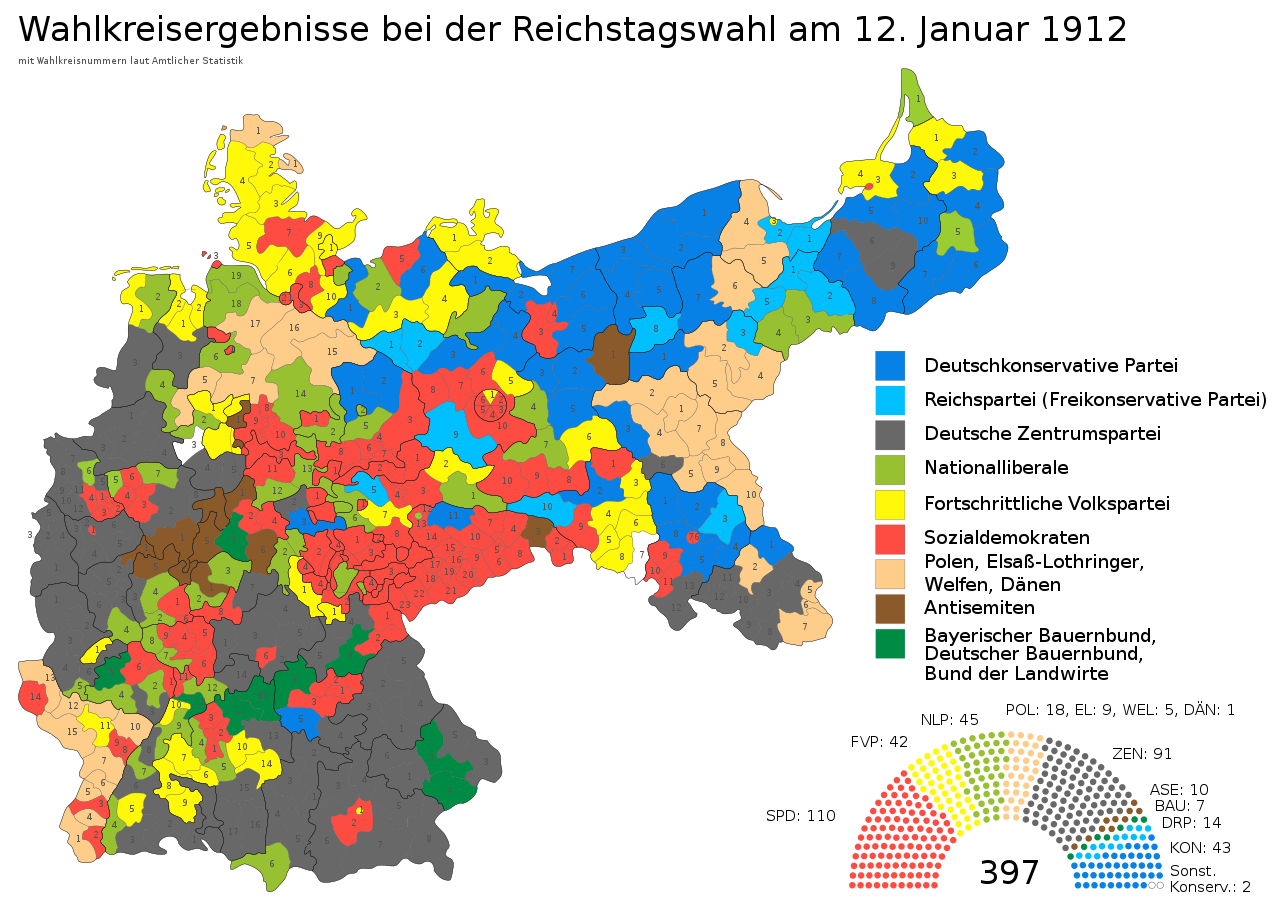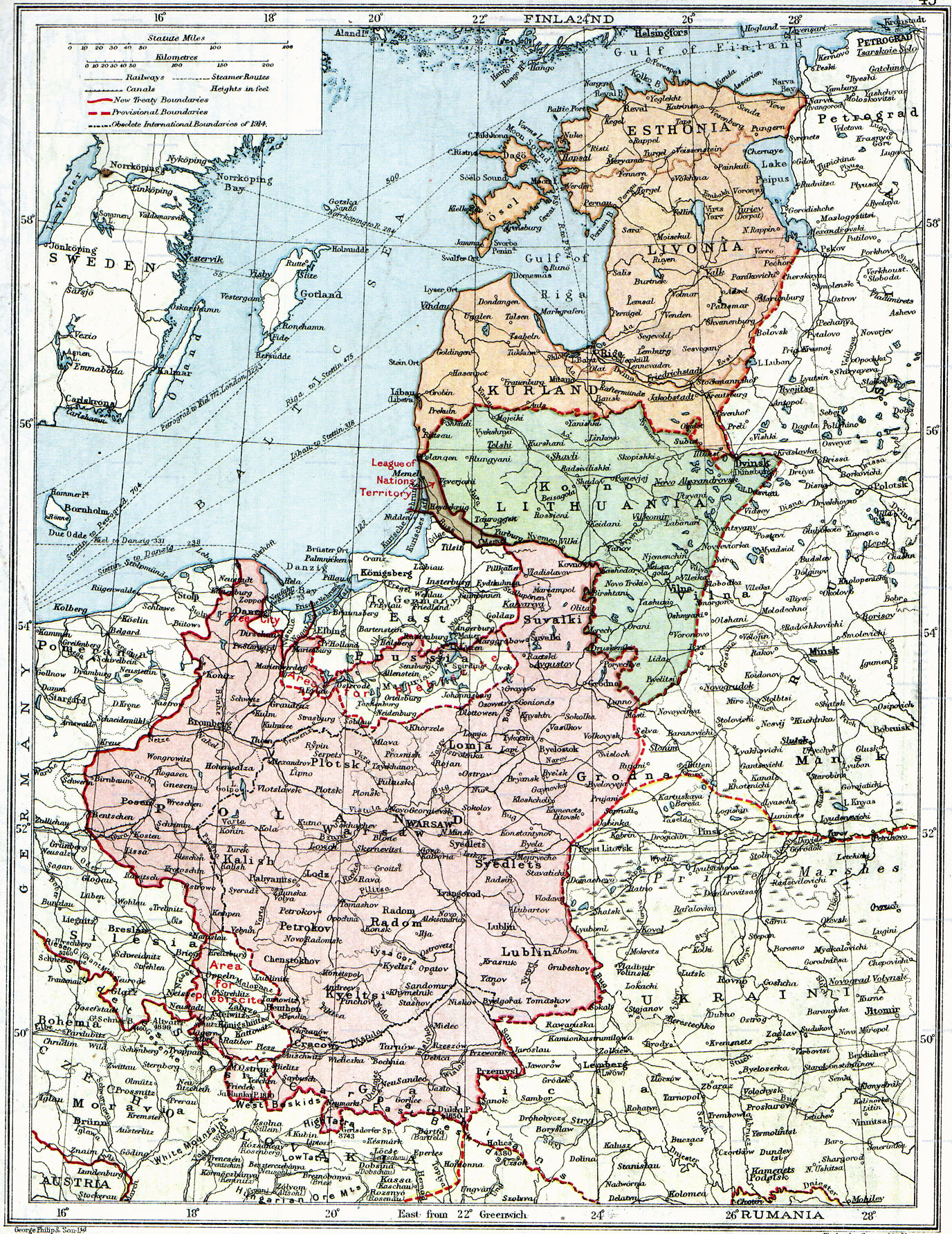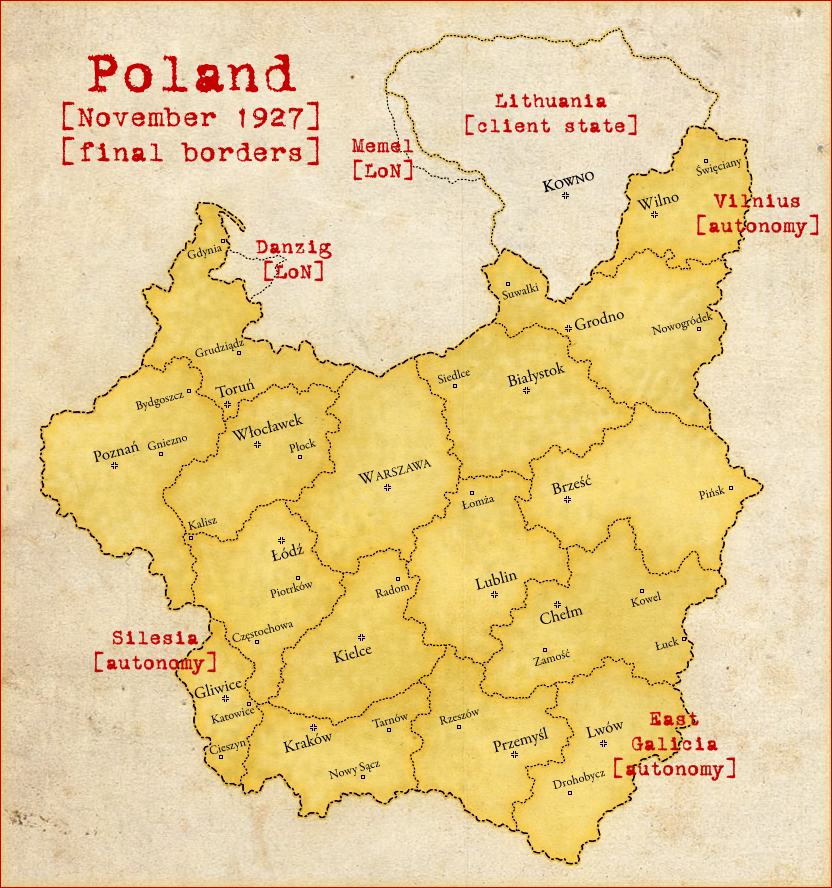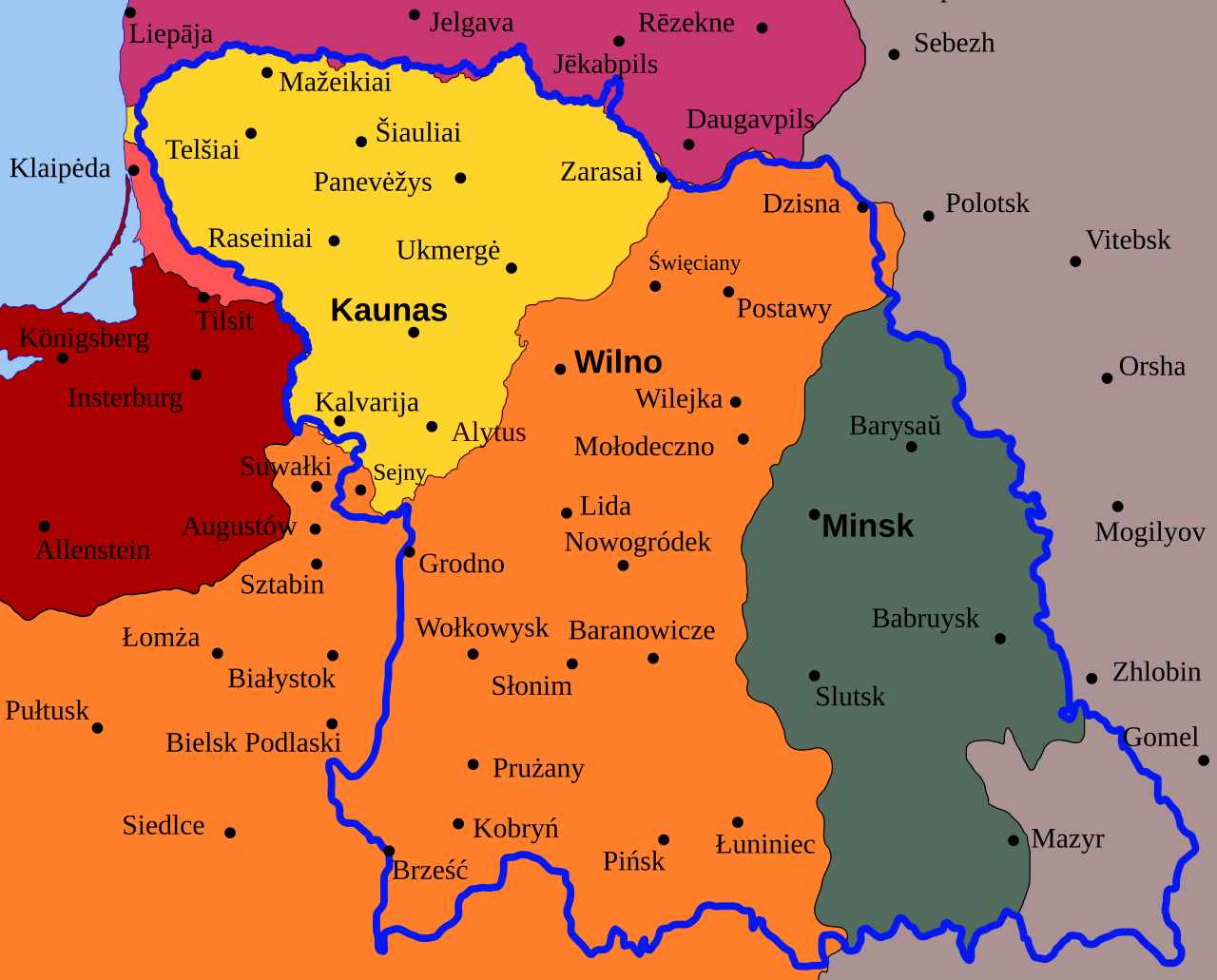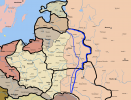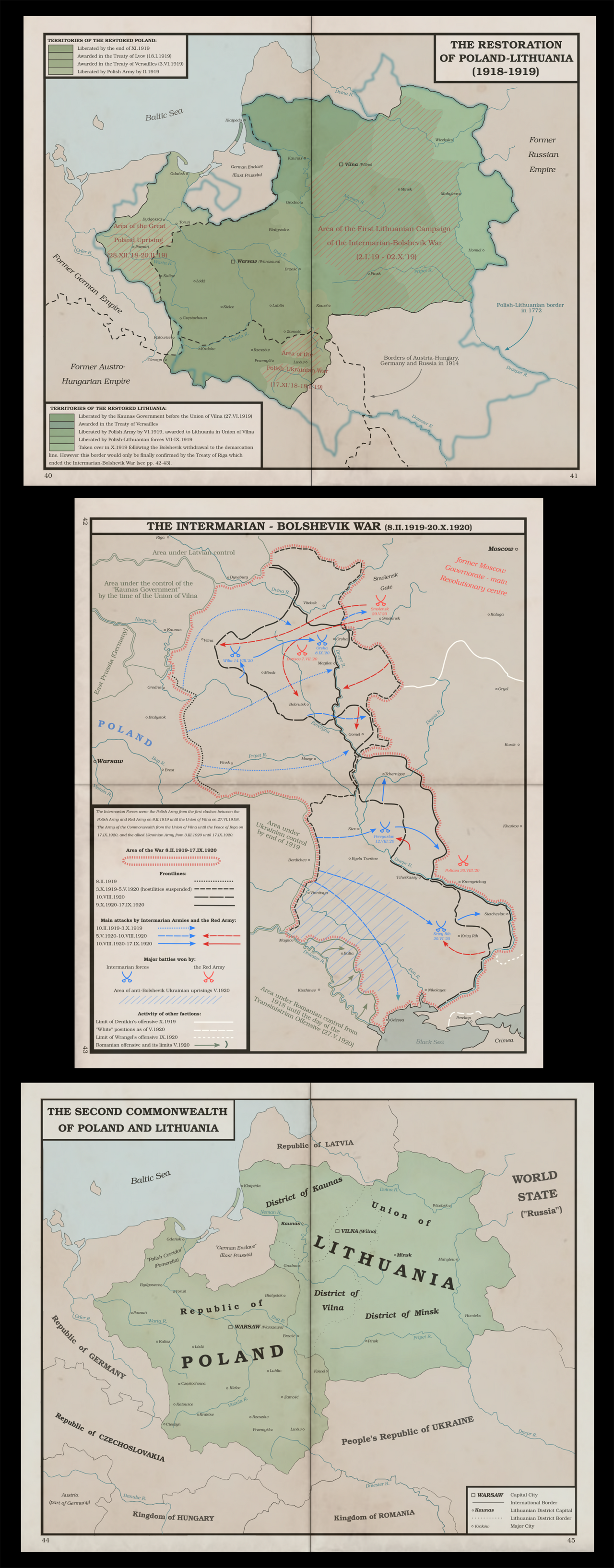This is the last post which recaps OTL to provide context and set the stage for what's to come. I had to cover some things very briefly to get the main points across without making this post too huge. After this one things will start diverging hard.
The Legacy of the Commonwealth
The Entente's concern with the revolution in Russia had caused them to mandate that Germany temporary keep its troops in much of the area in the east which they had occupied in 1918. But this was not permanent and in the beginning of 1919 they would withdraw completely. In the north they abandoned the various paramilitaries which represented the German upper classes of what would become Latvia and Estonia to fight a doomed battle against the Latvian and Estonian majorities inhabiting those areas. In the south they left a fragile and unpopular Ukraininan state governed from Kiev whose area would eventually become one of the main battlegrounds of the Russian Civil War. The central part of the vast occupied area was for the most part left in a state of near anarchy.
That large area bounded roughly by the rivers Neman, Dnepr, Dvina and Pripet in the west, east, north and south respectively had once constituted the heartland of the old Grand Duchy of Lithuania. The Liteuvan[] people who lived by the river Neman had first taken control over this area in the middle ages displacing the weakening Mongols. They then proceeded to capture most of Ukraine and even the westernmost areas of what is now Russia proper creating one of Europe's largest states. But despite its size this truly grand Duchy was not in the long term strong enough to fend off all external threats. The most pressing danger was to the Liteuvan heartland by the lower Neman which was threatened by the German states forming there. This provided the impetus for the alliance and dynastic union with Poland which would last for two centuries. For that period the union was still not as close as it would eventually become. But in the sixteenth century a series of wars made it clear that Lithuania was no longer a peer to the rising Muscovy. This caused Grand Duke of Lithuania and King of Poland Sigismund II to decide that if Lithuania were to survive in a recognizable form it would have to enter into a closer union with Poland. This goal was eventually accomplished in the Union of Lublin of 1569 which formed the Polish-Lithuanian Commonwealth. The resulting Lithuania was considerably smaller than the Grand Duchy had once been having lost considerable areas in the east to Muscovy and with its remaining portion of Ukraine transferred to Poland. But it would retain these boundaries and a certain degree of autonomy for over two more centuries.
All these events had taken place long before the rise of modern nationalism in the nineteenth century. In the days of the Commonwealth the only politically active class were the nobility[1]. Lithuania's nobles for the most part found the new political culture which they encountered by the Commonwealth very attractive. The literary and musical culture transmitted from Poland was also well received. This led to a gradual polonization of the Lithuanian nobility who eventually came to see Lithuanian-ness as a regional sub-identity of the wider Commonwealth. Since by the time the nobility (who in Poland-Lithuania constituted about 10% of the population) were the only people whose political opinions mattered it can be said that by the political standards of the time the Grand Duchy of Lithuania became ethnically Polish. Such a view of course ignored the peasantry who made up the overwhelming majority of the area's population. Perhaps if Poland-Lithuania had survived longer this polonization would have reached the peasantry as well. But the annexation of the entire territory of the Grand Duchy by Russia at the turn of the nineteenth century prevented such developments from continuing. And so the arrival of modern nationalism in Lithuania would create an interesting and confusing situation.
The most notable consequence of the nationalistic wave was the emergence of modern Liteuvan nationalism. While the nobility of the areas lying near the lower Neman and Vilia rivers had largely adopted the Polish language and customs the peasants had retained the old language of the medieval conquerors of the area. And while much of the nobility (and the rising intelligentsia which largely descended from it) continued to see ties with Poland as something natural the new Liteuvan nationalists took a different view. In their view the Poles had effectively "stolen" their nation's elites by assimilating them. It may have been a voluntary process but this only made the pervasive Polish culture even more dangerous. In their view any continued association with Poland would be an existential threat to their very identity. The struggle between the emerging Polish and Lithuanian nationalisms was farther exacerbrated by territorial disputes.
Much like those traditionally-minded Poles who considered the former Lithuania in its entirety to be for all intents and purposes a part of Poland the new Liteuvan nationalists were also living in the past. This was made most obvious by the Vilna dispute. Vilna was the old capital of Lithuania and at one point it and the surrounding areas had been ethnically Liteuvan. But in the days of the Commonwealth cultural Polonization and the arrival of Polish settlers had effectively polonized a large strip of territory stretching from the old ethnic core of Poland to the northeast. It included cities like Białystok, Suwałki, Grodno and most significantly Vilna itself. By 1914 the number of ethnic Lithuanians in Vilna and its surroundings was only several per cent of the total population. But like the Greeks who claimed the mostly Turkish constantinople and coastline of Asia Minor the Liteuvan nationalists would eventually demand Vilna once their nation-state finally formed.
The Belarusians and Jews for the most part remained politically passive. The Jews were developing their own version of nationalism focusing on establishing a Jewish state preferably in Palestine. This made them largely indifferent to the political struggles of the central europeans. Whatever country would eventually come to own a Jew's town or village it would certainly not be a Jewish state. This of course led to accusations of indifference and even treason exacerbrated by the fact that marxism with its promise of an end to ethnic disputes gained some popularity among the Jews.
The Belarusians for their part remained politically passive. But just because modern nationalism had not yet taken hold among them did not mean that it could not do so eventually.
This confused ethnic situation existed in 1914. Following their offensives of 1915 the Germans occupied the western parts of the old Grand Duchy of Lithuania bringing it under miltiary administration. It took some time before the fate of this area (the so-called Ober-Ost) would be decided but eventually the occupying Germans would begin to lay the foundations for a semi-colony in the form of a Liteuvan nation state. At the time they did not trouble themselves with the area farther to the east. The anticipated cession of the areas which they already controlled by 1915 from Russia would already have represented a huge cession by the standards of the nineteenth century. As late as the first round of the negotiations at Brest-Litovsk Germany did not ask for the transfer of any significant areas east of Vilna and Riga to their control. It was only the Bolshevik's decision to continue the war despite their considerable weakness that led to Germany's opportunistic occupation of the reminder of the Neman-Dnepr-Dvina-Pripet quadrilateral. But the Germans themselves had no clear idea what to do with that territory and with their defeat on the western front several months later they lost all interest in the subject. As a result they made no significant efforts to organize any local government in the area before their withdrawal in 1919.
The resulting vacuum was at first filled by a number of minor organizations. Some of these were purely local affairs with no interest in the outside world. Others proclaimed some sort of association with an external body (in this case Poland) but never made contact with it. Several communes formed which claimed a loose association with the Bolsheviks. The Polish militias which took control of Vilna claimed association with Poland but its geographical isolation from the areas under control of Poland proper and the general difficulties in communication made this theoretical. The Belarusian People's Republic which formed in Minsk proclaimed itself to be the government of a large state stretching from Smolensk and Homel to Vilna and Bialystok even though it gained virtually no popular support. In the absence of any notable state in that area its fate would therefore be determined by those outside forces with the will and power to intervene.
The powers which were at this time convening in Paris pointedly avoided any sort of territorial decisions[3]. In practice the Entente would just the situation which had emerged by itself with quite limited involvement from their part. The Liteuvan state in the northwest was strong enough to establish itself as a force of some importance on its own territory but was unable to secure Vilna. Latvia in the north and Ukraine in the south were so embroiled in their own conflicts that they had no attention to spare. This left Poland and Revolutionary Russia as the main forces which would determine the area's future.
At this point it was not clear how Poland would act if given the opportunity. Poland's national movement (the National Democrats) were nationalists of the modern type. In their view the rebuilt Poland was to be a unitary nation-state. In their view territories containing minorities could be incorporated but only if they were thought to be easy to assimilate without the need for radical antidemocratic methods which would undermine the state in the long term. In practise this means that they opted for Poland ethnic boundary in the north (with Latvia and Lithuania although the latter was treated as a possible client state its nationalism being considered too advanced to make assimilation convenient) west (with Germany) and south (with Czechoslovakia). The Ukrainian- and Belarusian-speaking areas just east of ethnic Poland were considered absorbable due to the low level of national consciousness especially among the Belarusians and due to the presence of an influential Polish minority. The National Democrats claimed territory as far east as Minsk but without deciding if they wished to include the city itself or not. Farther annexations in the east would be a mistake in their view since they would increase the number of Ukrainians and Belarusians within Poland too greatly. Because of the size and influence of their movement it seemed reasonable to expect that they would get their way [5].
If not for the presence of Joseph Piłsudski. He had no political movements or think tanks backing him that could hope to match those of the National Democrats. But as the head of state he was Poland's most influential individual. He had no major caveats about the National Democrats' plans for the west. But his views on the future of the former Grand Duchy of Lithuania differed wildly from those of his opponents. Instead of having a Polish nation-state cutting off those parts of the former Poland-Lithuania which were deemed too troublesome to keep he envisioned the restoration of an updated version of the old Poland-Lithuania. He was no doubt ready to see it modernized and updated. But any arrangements would need to conform with the general principle of restoring a Lithuanian entity rougly within its 1772 borders and united with Poland. To the National Democrats this was an outdated and utopian (and possibly even harmful) idea. Of course Pilsudski himself was in principle ready to entertain the restoration of Poland as an ethnic nation-state. But to him it would be a last resort to be entertained only if his grander plans failed[5].
The Bolsheviks' view was fairly simple. All of the former Grand Duchy was to become part of a communist world state. The administrative boundaries within that state were a matter of secondary concern. Interestingly the idea that Lithuania should remain a single unit was present among them as well. They proposed to administer most of the area as a Lithuanian-Belorussian People's Republic which would be known as the "Litbel"[6].
As 1918 ended the Red Army began its march west. Soon afterwards Polish forces freed from their struggle against Ukraine began to move east. In the last days of 1918 the Red Army reached Vilna and ejected the Polish militia from the city marking the first conflict between Polish-aligned forces and the Red Army. In another month the area vacated by the Germans had mostly come under the control of the Red Army with the Polish Army having occupied the small reminder. The revolutionary ambitions of Moscow made its objectives entirely incompatible with those of Warsaw. The inevitable clashes between the Polish and Red Armies started in Febuary 1919.
The war between the Poles and Bolsheviks had begun.
[1] This post recaps events in our timeline but from the perspective of the alternate one. It therefore uses some alternate designations.
[2] Past circumastances had reduced royal power to the point where the Commonwealth effectively emerged as what was more or less a democratic constitutional monarchy. By modern standards it would certainly be considered flawed. Full civic rights only applied to the nobility who constituted about 10% of the state's population. And while the so-called Pacta Conventa which the newly elected King would have to abide by were only a primitive predecessor to modern constitutions they severely limited his power. But by the standards of the time this constituted a liberal revolution. The urban and mercantile classes had been sidelined and their roled had been largely taken by the large numbers of Jews fleeing persecution elsewhere in Europe. The nobility found it very convenient that the Jews took on the role which would otherwise be dominated by native merchants since unlike them the Jewish communities were isolationist and lacked political ambitions. The peasantry at the time had virtually nothing to say in politics. The near elimination of the other classes and estates besides the nobility granted that class an influence over their country's affairs unseen elsewhere.
[3] It is a common miscocneption that the Curzon Line as it was drawn up in 1919 was meant to be the final eastern border of Poland instead of the boundary between what would definitely be Poland and entirely undefined areas. This line was instead meant only as the eastern limit of those areas of the former Russian Empire which were definitely to become Poland's without deciding if Poland was to annex any areas to the east. The territory east of the Curzon Line was purposefully left undefined to be decided upon later once the Russian Civil War resolved itself. A second misconception is that Curzon's original Line extended into Galicia. The line was meant to apply only to the former Russian Empire. The extension of the Line into Galicia was made later.
[4] Our timeline's Second Republic of Poland came very close to achieving the nationalists' dream borders. The Free City and the parts of the plebiscite regions which remained with Germany were just about all that was missing. They did claim Minsk in the 1919 negotiations in Paris but apparently didn't feel attached to it. This was demonstrated by the fact that in our timeline the Polish delegation to the postwar negotiations with the Bolsheviks at Riga declined the city even though they apparently could have received it. The claim to Minsk may have been just a typical negotiation tactic in which one demands more than one truly wants in order to make withdrawing the claim to an unwanted item seem like a concession.
[5]
This is a nice old map by
@Magnificate showing an alternate Poland with an eastern border being more or less what Piłsudski would have viewed as a minimum satisfactory version.
[6] The Litbel was a real thing. According to Wikipedia its borders were supposed to be the blue line. The other borders on this map are the ones which eventually formed in our timeline.
